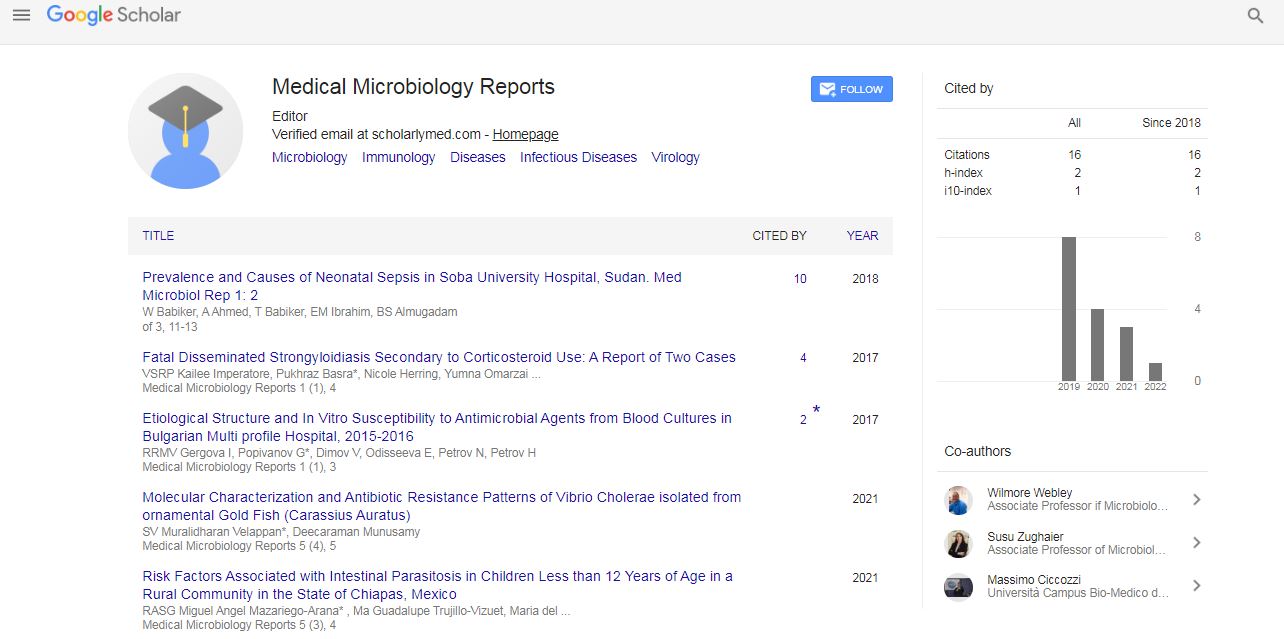Editorial, Med Microbiol Rep Vol: 6 Issue: 1
Bacterial Metabolism Growth Evolution
Avinash kumar*
Department of Biological Science, Biological Sciences, University of Delhi, Delhi, India.
*Corresponding Author: Avinash kumar
Department of Biological Science, Biological Sciences, University of Delhi, Delhi, India.
Email: avinash9239@gmail.com
Received date: 03January, 2022; Manuscript No. MMR-22-56651;
Editor assigned date: 07January, 2022; Pre QC No. MMR-22-56651(PQ);
Reviewed date: 17January, 2022; QC No. MMR-22-56651;
Revised date: 24January, 2022; Manuscript No: MMR-22-56651(R);
Published date: 03February, 2022; DOI:10.4172/mmr.1000e001
Citation: Avinash k (2022) Bacterial Metabolism Growth Evolution. Med Microbiol Rep 06:01.
Keywords: bacteriology
Introduction
At this factor it's far herbal to speak about some preferred properties of bacterial communities. Classical bacteriology long held that best pure laboratory cultures have been worth of observe. This explains why the interdependency of different styles of bacteria became for a long time left out and microbial useful biology becomes incompletely understood. Right here we are able to emphasize flows of electricity and be counted; spatial and temporal patterns of microbial groups are dealt with in a following section. In a single recognize cardio heterotrophic microorganisms and the groups they form range fundamentally from their anaerobic opposite numbers [1]. The difference turned into apparent from Individual aerobic microorganism can, in almost all instances, mineralize their substrates completely. One-of-a-kind species are specialised with recognize to which, if any, polymers they can hydrolyse and which specific low molecular weight organics they take up and dissimilate and assimilate. but, almost all have the entire enzymatic equipment (e.g., glycolytic pathway, citric acid cycle, electron shipping chain) to effect a complete mineralization of carbohydrates and amino acids with metabolic quit products which include bacterial cells+CO2+H2O+mineral N, etc. Furthermore, due to a relative efficient electricity metabolism, an exceedingly huge fraction of the fabric metabolized ends up as new mobile biomass.
In assessment, the fantastically decrease lively efficiencies of anaerobic metabolism way that a far large fraction of the substrates is dissimilated, that is, turns up as metabolites as opposed to being incorporated into mobile fabric. Moreover, few anaerobes, excepting denitrifiers and some iron and sulfate reducers, appear capable of completely mineralizing multi-carbon substrates, for instance, glucose [2]. Anaerobic mineralization takes location stepwise concerning a "food chain" or "food web" composed of numerous distinct purposeful forms of microorganism. It could logically be requested why there are no anaerobes that hydrolyze cellulose into glucose, then ferment the glucose thru glycolysis, metabolize glycolytic stop merchandise to hydrogen and acetate, and subsequently produce CH4+CO2. One clarification can be that the genetic "load" required to code for the suite of necessary proteins is selectively disadvantageous; similarly, law of such various methods within an unmarried cell might require a degree of compartmentalization incompatible with constraints imposed by way of size and inner shape. Regardless of the cause, the requirement for a couple of useful forms of anaerobes to absolutely degrade organic be counted has a profound effect at the company of anaerobic communities [3].
Bioenergetics and the Shape of Bacterial Groups
In anaerobic groups and expansion of fermenting bacteria are completely chargeable for the hydrolysis of organic polymers yielding different fatty acids, alcohols, and H2 as metabolite. In sulfate-containing habitats (sulfate concentrations>approximately 0.1 mM), these quit merchandise are further degraded by means of sulfate reducers, which can be accountable for the terminal anaerobic mineralization steps [4]. Within the absence of sulfate, other kinds of fermenters are essential for the conversion of all substrates (butyrate, propionate, etc.) into acetate+H2 which can be utilized by methanogens for terminal mineralization. These fermenters are known as obligate acetogens [5].
The relative roles of hydrogenotrophic methanogens and homoacetogens have drawn some interest. Plainly below acidic conditions (pH<5), the latter are competitively superior and play the position of H2 scavengers. The resulting acetate they produce is then degraded through acetoclastic methanogens. In more neutral environments hydrogenotrophic methanogens dominate H2 consumption [6]. As formerly mentioned, interspecies H2 transfer is a critical function of anaerobic mineralization: Handiest the efficient removal of H2 through methanogenesis or anaerobic breathing allows for the crowning glory of the fermentation strategies. In any other case the environment will become acidic and in addition mineralization is inhibited. That is a trouble that can cause the failure of improperly managed anaerobic waste digesters and to fatal situations in ruminants [7].
Fermentation
Fermentation holds a special place in biogeochemistry in that it does no longer in precept trade the redox capability of the environment. This is due to the fact electricity conservation (ATP synthesis) is coupled to the dismutation of natural molecules without changing the overall reduction-oxidation country of reactants relative to merchandise. Fermentation represents the basis of anaerobic degradation, but due to the fact external electron acceptors aren't concerned it does not feature five–it is able to be considered as a process in which substrates remain at the extent of CH2O [8]. (Direct measurements of electrode potentials, however, will suggest that a culture of fermenting microorganism reduces the environment. that is because the substrates of fermenters, e.g., cellulose, do no longer truly display electrochemical interest while a number of the metabolites, e.g., H2 will lower measured electrode potentials.)
The statistics furnished in is largely equivalent to the records supplied, however honestly emphasizes which strategies are thermodynamically viable. The figure additionally affords a simplified biosphere model [9]. The driving pressure is oxygenic photosynthesis that creates a chemical energy ability constituted by way of O2 and decreased organic count (CH2O). Part of the chemical strength stored in organic be counted will be launched through fermentation, however most could be released thru oxidation-reduction methods (breathing) concerning external electron acceptors. As long as O2 is available, oxidative phosphorylation will be accountable for mineralization. When oxygen is depleted, energetically much less beneficial NO3− discount will take over (to the volume that nitrate is to be had) accompanied through the reduction of oxidized Mn and Fe, sulfate reduction, and hydrogenotrophic methanogenesis in that order. This redox series describes and explains the temporal succession of decay of organic matter and the spatial distribution of approaches in widespread terms. For instance, when going downwards from the floor of aquatic sediments, different electron acceptors are sequentially depleted: First O2, then NO3− followed with the aid of oxidized Mn and Fe, and finally SO42−. Even as the energetics explains this sample, the quantitative significance of the person methods is basically decided by way of the provision of the distinctive electron acceptors; in most marine habitats aerobic respiratory and sulfate discount predominate on this recognize [10]. The combination of techniques that account for mineralization in freshwater structures is greater variable, even as in soils cardio respiration normally dominates.
Reference
- Jurtshuk P Jr, Mueller TJ, Wong TY (1981) Isolation and purification of the cytochrome oxidase of Azotobacter vinelandii. Biochim Biophys Acta 637: 374.
[Crossref] [Google Scholar] [Indexed]
- Deacon J, Cooper RA (1977) D-galactonate utilisation by enteric bacteria. The catabolic pathway in Escherichia coli. FEBS Lett 77: 201–205.
[Crossref] [Google Scholar] [Indexed]
- Hoskisson PA, Rigali S, Fowler K, Findlay KC, Buttner MJ (2006) DevA, a GntR-like transcriptional regulator required for development in Streptomyces coelicolor. J Bacteriol. 188: 5014–5023.
- Magnez R, Thiroux B, Taront S, Segaoula Z, Quesnel B, et al. (2017) PD-1/PD-L1 binding studies using microscale thermophoresis. Sci Rep 7: 17623.
[Crossref] [Google Scholar] [Indexed]
- Reuther J, Wohlleben W, Muth G (2006) Modular architecture of the conjugative plasmid pSVH1 from Streptomyces venezuelae. Plasmid 55: 201–209.
[Crossref] [Google Scholar] [Indexed]
- Zheng M, Cooper DR, Grossoehme NE, Yu M, Hung LW, et al. (2009) Structure of thermotoga maritima TM0439: Implications for the mechanism of bacterial GntR transcription regulators with Zn2+-binding FCD domains. Acta Crystallogr D Biol Crystallogr 65: 356–365.
[Crossref] [Google Scholar] [Indexed]
- Choudhary GS, Yao X, Wang J, Peng B, Bader RA, et al. (2015) Human granulocyte macrophage colony-stimulating factor enhances antibiotic susceptibility of Pseudomonas aeruginosa persister cells. Sci Rep 5: 17315.
[Crossref] [Google Scholar] [Indexed]
- Chubukov V, Uhr M, Le Chat L, Kleijn RJ, Jules M, et al. (2013) Transcriptional regulation is insufficient to explain substrate-induced flux changes in bacillus subtilis. Mol Syst Biol 9: 709.
[Crossref] [Google Scholar] [Indexed]
- Sternberg C, Tolker-Nielsen T (2006) Growing and analyzing biofilms in flow cells. Curr Protoc Microbiol 1B.2.1–1B.2.15.
[Crossref] [Google Scholar] [Indexed]
- Wahl SA, Dauner M, Wiechert W (2004) New tools for mass isotopomer data evaluation in 13C flux analysis: Mass isotope correction, data consistency checking, and precursor relationships. Biotechnol Bioeng 85: 259–268.
[Crossref] [Google Scholar] [Indexed]
 Spanish
Spanish  Chinese
Chinese  Russian
Russian  German
German  French
French  Japanese
Japanese  Portuguese
Portuguese  Hindi
Hindi 
